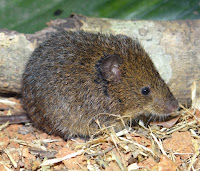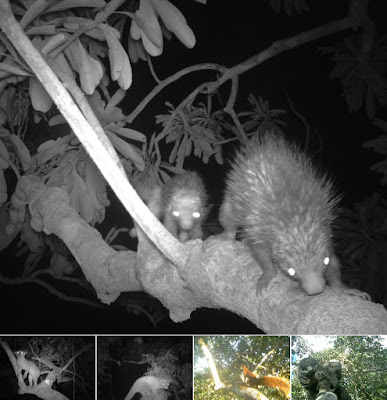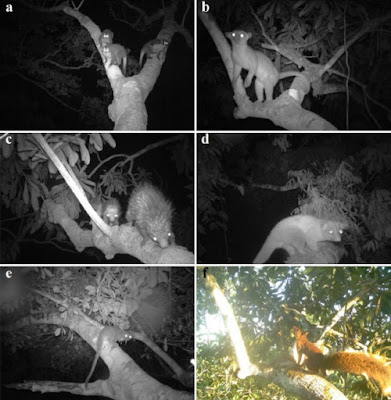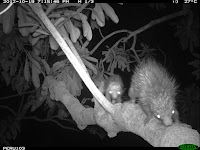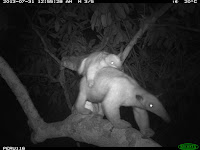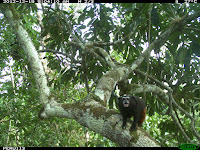![]() |
Plethoscorpiops profusus Lourenço, 2017
|
Abstract
Plethoscorpiops profusus gen. n., sp. n., belonging to the family Scorpiopidae Kraepelin, 1905 is described on the basis of two specimens, one adult female and one male juvenile collected in the Saddan Cave, in Kayin State, Hpa-An, Burma (Myanmar). This new scorpion taxon most certainly represents an endemic element for the fauna of Burma and seems to be strictly distributed inside the cave system. The new genus is characterized by a previously unknown and totally unique plethotaxic trichobothrial pattern within the family Scorpiopidae.
Keywords: Scorpion, Scorpiopidae, Burma, New genus, New species, Trichobothrial pattern
![]() |
Fig. 5. Plethoscorpiops profusus sp. n. Female holotype alive (photo A. Kury).
Fig. 2. The region where is located the Saddan Cave, showing the outside relief and typical vegetation (photo: F. Bréhier). Fig. 4. Interior view of the Saddan Cave, showing the limestone walls with the crevices where the specimens were found (photo A. Kury). |
Taxonomic treatment
Family Scorpiopidae Kraepelin, 1905
Genus Plethoscorpiops gen. nov.
Diagnosis for the new genus: The new genus presents most of the characteristics already defined for the family Scorpiopidae and several of these characters associate it with both Alloscorpiops and Dasyscorpiops. It can, however, be characterized by a very particular trichobothrial pattern of some ‘territories’ or series. Femur with three trichobothria: dorsal, internal and external. Patella with two dorsal, one internal, 23 ventral and a very high number of 41 external trichobothria (up to 42–43 in the male paratype). Most outstanding are the values found for chela-hand with 25 ventral, two dorsal (Dt, Db), two internal (ib, it), 3 Est, 6 Et, Esb and a very high number of 19 trichobothria in the Eb series. This latter number is particularly unusual, because in the other genera of the family, only three (or five) trichobothria are observed on Eb series. See the following taxonomic comments.
Type species: Plethoscorpiops profusus sp. n.
Etymology: The generic name is an association of plethos with scorpiops and refers to the very high numbers of trichobothria found in the chela of pedipalps. From Latin plethora, originate from ancient Greek πληθώρη (plēthōrē) = plenty.
![]() |
| Fig. 1. Map of Southeast Asia showing the known distribution of genera Alloscorpiops, Dasyscorpiops and Plethoscorpiops. Notice that the type locality of Dasyscorpiops grandjeani, Malacca is dubious (according to Fage's personal notes). |
Description of the new species
Plethoscorpiops profusus sp. n.
Burma (Myanmar), Kayin State, Hpa-An, Saddan Cave, 250 m alt., about 90 m from the entry, hidden in wall crevices, 31/VII/2016 (A. Giupponi & A. Kury leg.).
Female holotype, deposited in the Museu Nacional, Rio de Janeiro; male juvenile paratype deposited in the ‘Muséum national d’histoire naturelle’, Paris.
Etymology: The specific name refers to the very high number of trichobothria presented by the new species.
Diagnosis: Species of moderate size relative to other species of the family Scorpiopidae, adult female 61.8 mm in total length. Coloration dark reddish-brown; three pairs of lateral eyes, the third pair reduced; pectines with 9–9 teeth in the female holotype and 12–13 teeth in the male paratype; fulcra reduced to vestigial. Annular ring clearly marked in the telson. Trichobothrial pattern as in generic diagnosis.
....
Wilson R. Lourenço. 2017. A New Genus and Species of Scorpion from Burma [Myanmar] (Scorpiones: Scorpiopidae): Implications for the Taxonomy of the Family.
{Un nouveau genre et espèce de scorpion de Birmanie [Myanmar] (Scorpiones : Scorpiopidae) : implicationsdans la taxonomie de la famille}. Comptes Rendus Biologies. In Press. DOI:
10.1016/j.crvi.2017.05.003 Résumé: Plethoscorpiops profusus gen. n., sp. n., appartenant à la famille des Scorpiopidae Kraepelin, 1905 est décrit sur deux spécimens, une femelle adulte et un mâle juvénile, collectés dans la grotte Saddan, située dans l’État de Kayin, Hpa-An, Myanmar. Ce nouveau taxon scorpionique représente très certainement un élément endémique pour la faune de Myanmar et semble strictement inféodé dans le système cavernicole. Le nouveau genre est caractérisé par un modèle trichobothriotaxique, pléthotaxique, encore inconnu et certainement unique parmi les scorpions de la famille des Scorpiopidae.
Mots clés: Scorpion, Scorpiopidae, Myanmar, Nouveau genre, Nouvelle espèce, Modèle trichobothriotaxique
















